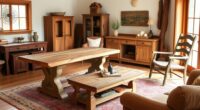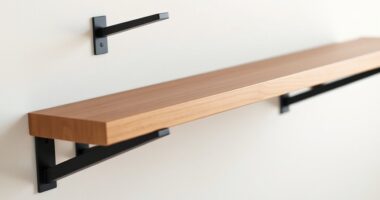If you’re looking for the best wood planers to achieve a smooth finish, I recommend checking out a variety of compact, electric, and manual options. From lightweight mini planers like the Jorgensen No.60-1/2 and 3.5-inch models to powerful electric tools like the WEN 6530, there’s something for every project. Edge shaping tools like chamfer planes also help refine details. Stay with me, and you’ll discover top picks, features, and tips to find the perfect planer for your needs.
Key Takeaways
- Top-rated models feature adjustable cutting depths for precise surface smoothing.
- Many offer lightweight, portable designs suitable for both hobbyists and professionals.
- High-quality blades made from durable steel ensure clean, smooth finishes on various wood types.
- Electric planers with powerful motors (over 1800W) handle tough milling tasks efficiently.
- Additional features like dust collection, foldable stands, and V-grooves enhance usability and surface quality.
Jorgensen No.60-1/2 6-1/4 Mini Wood Planer
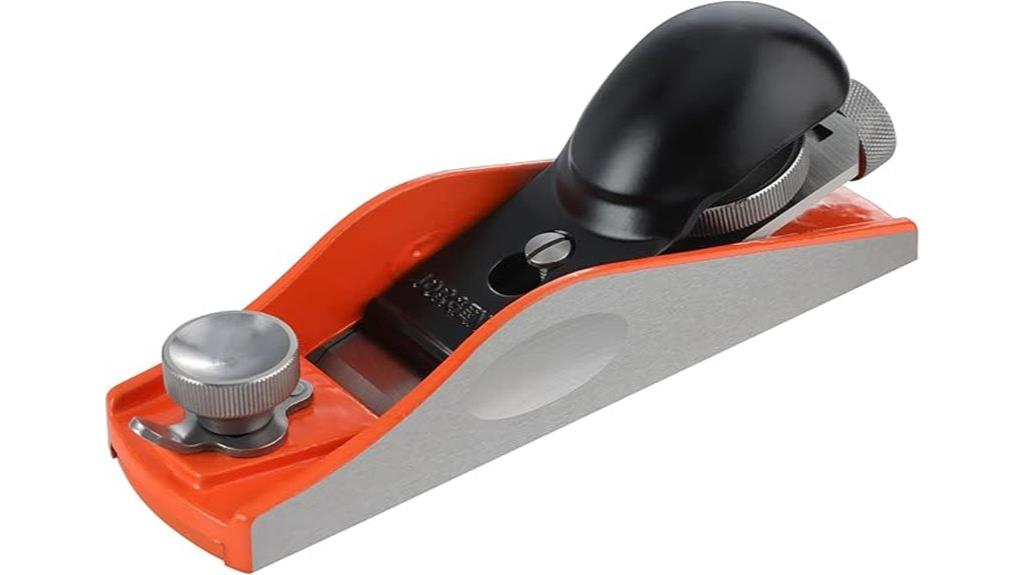
If you’re looking for a reliable, budget-friendly tool for light woodworking and craft projects, the Jorgensen No.60-1/2 6-1/4 Mini Wood Planer is an excellent choice. Its compact, manual design makes it ideal for smoothing, trimming, and deburring small pieces. Crafted with a ductile iron body and stainless steel components, it’s built to withstand heavy use. The sharp, professional-grade blade can be sharpened and adjusted repeatedly, ensuring long-lasting performance. With a flat, polished sole and adjustable cutting depth, this planer offers precise control. Weighing just under two pounds, it’s easy to handle, making it perfect for both beginners and experienced woodworkers.
Best For: DIY enthusiasts and amateur woodworkers seeking a budget-friendly, compact tool for light woodworking, smoothing, and trimming small pieces.
Pros:
- Sharp, professional-grade blade that can be sharpened and adjusted repeatedly for extended use.
- Compact, lightweight design weighing just under two pounds for ease of handling and maneuverability.
- Adjustable cutting depth and polished flat sole for precise control and smooth finishes.
Cons:
- May require initial flattening of the sole and honing of the blade upon arrival.
- Not suitable for heavy-duty or fine woodworking that demands more refined tools.
- Some users might find the tuning process necessary to achieve optimal results.
JORGensen 3.5 Mini Wood Planer for Woodworking

The JORGENSEN 3.5 Mini Wood Planer stands out as an ideal choice for woodworking enthusiasts who need a compact, precise tool for detailed projects. Weighing just 8.8 ounces and measuring 3.5 inches, it’s perfect for intricate trimming, polishing, and deburring. Its durable ductile iron body and stainless steel parts ensure long-lasting performance, while the high-quality 9CrWMn blade delivers sharp, efficient cuts. The adjustable depth knob offers precise control, making it suitable for tight spaces and fine finishing. Despite its small size, it provides excellent control and accuracy, making it a valuable addition for hobbyists and professionals tackling delicate woodworking tasks.
Best For: hobbyists and professionals who need a compact, precise tool for detailed woodworking, trimming, polishing, and deburring in tight spaces.
Pros:
- Compact and lightweight design for easy handling and control
- Durable construction with a high-quality blade for sharp, efficient cuts
- Adjustable depth knob allows precise control over shaving thickness
Cons:
- Small size may require extra care to avoid misalignment
- Depth adjustment can be finicky and may take some time to master
- Limited cutting width of 1.25 inches, suitable mainly for detailed work rather than large surfaces
Jorgensen Chamfer Plane for Woodworking
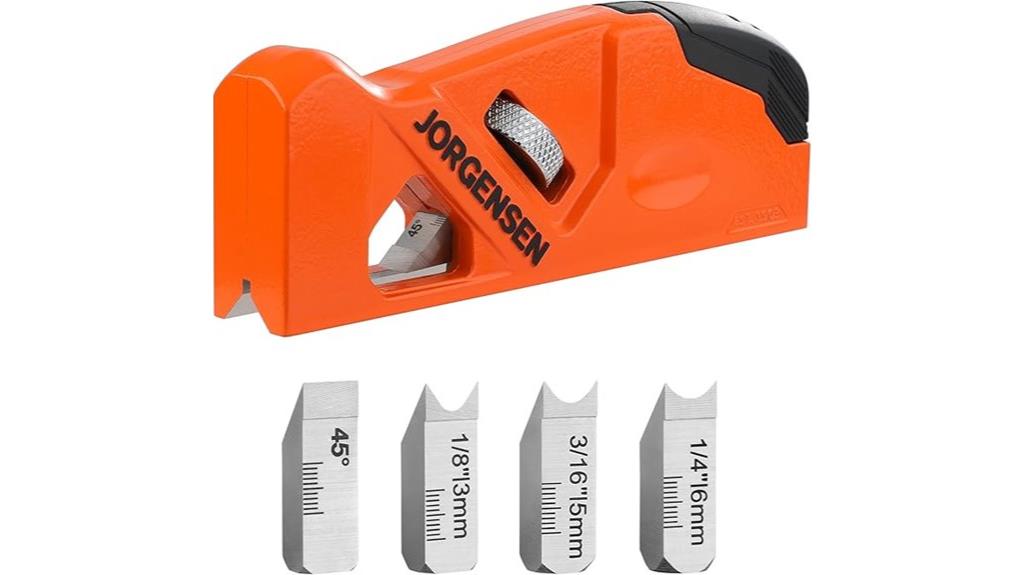
The Jorgensen Chamfer Plane stands out as an excellent choice for woodworkers seeking precise edge shaping and chamfering. Its durable aluminum body offers a lightweight feel without sacrificing sturdiness, reducing fatigue during prolonged use. The ergonomic design and grip groove provide added control and comfort. With four interchangeable cutter heads—45°, 1/4 round, 3/16 round, and 1/8 round—it’s versatile for different profiles. The finely sharpened blades, made from tough 9CrWMn steel, ensure efficient cuts. Easy blade swaps and adjustable depth make it suitable for soft and hard woods. Overall, it’s a reliable, high-quality tool perfect for detailed edge finishing.
Best For: woodworkers and woodworking enthusiasts seeking precise edge shaping, chamfering, and detailed finishing on soft and hardwoods.
Pros:
- Durable aluminum body offers lightweight handling and robustness
- Four interchangeable cutter heads provide versatile profiling options
- Easy blade swapping and adjustable depth for customized results
Cons:
- May require tuning for optimal performance on very hard woods
- Out-of-the-box blades might need sharpening for best results
- Slight challenges with initial setup and blade alignment for some users
WEN 6530 6-Amp Electric Hand Planer, 3-1/4-Inch
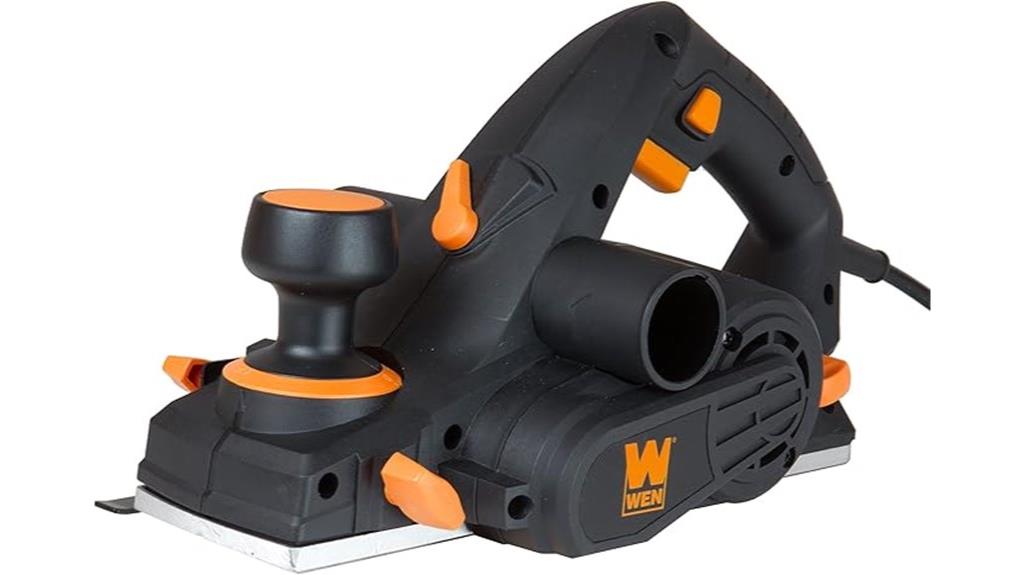
Designed for both DIY enthusiasts and professionals, the WEN 6530 6-Amp Electric Hand Planer stands out with its powerful motor capable of making over 34,000 cuts per minute. Its 3-1/4-inch width and 1/8-inch maximum depth allow for efficient surface smoothing, door fixing, and board squaring. The adjustable depth stops in 1/128-inch increments provide precise control, while the lightweight design (just 6 pounds) ensures easy handling. Additional features like the V-groove base for corners, dust bag, rabbeting guide, and parallel fence make it versatile and user-friendly. Overall, it offers solid performance at an affordable price point for both hobbyists and pros.
Best For: DIY enthusiasts and professionals seeking a powerful, precise, and affordable hand planer for smoothing, fitting, and squaring wood surfaces.
Pros:
- Powerful 6-amp motor delivering over 34,000 cuts per minute for efficient work
- Precise depth control with 16 adjustable stops in 1/128-inch increments
- Lightweight design (6 pounds) for easy handling and reduced fatigue
Cons:
- Dust bag fills quickly, requiring frequent emptying during extended use
- Manual can be somewhat basic, with instructions sometimes needing external references
- Motor ticking sounds reported by some users, indicating potential maintenance needs
JORGENSEN 3.5 Mini Wood Planer for Woodworking
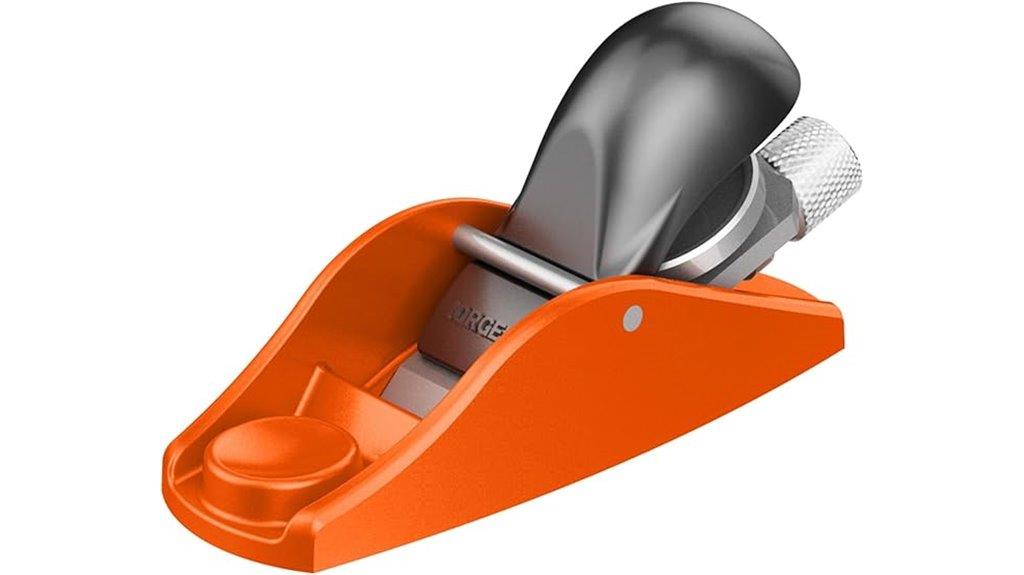
If you’re looking for a compact and precise hand plane for detailed woodworking tasks, the JORGENSEN 3.5 Mini Wood Planer fits the bill perfectly. Weighing just 8.8 ounces, it’s ideal for trimming, polishing, and crafting in tight spaces. Its durable ductile iron body and high-quality O1 steel blade ensure long-lasting sharpness and effective cuts. The adjustable depth knob offers fine control, making it suitable for delicate projects. Its flat sole guarantees smooth operation, and the small size provides excellent handling. With a customer rating of 4.5 stars, this mini planer is praised for its precision, affordability, and rugged build—perfect for both hobbyists and professionals.
Best For: hobbyists and professionals seeking a compact, precise hand plane for detailed woodworking, trimming, and finishing in tight spaces.
Pros:
- Lightweight and ergonomic design for easy handling and control.
- Durable construction with high-quality materials like ductile iron and O1 steel blade.
- Adjustable depth knob allows for precise shaving control and fine finishing.
Cons:
- Small size may require some getting used to for larger projects.
- Finiteness of depth adjustment can be tricky for some users.
- Limited cutting width of 1.25 inches may not suit broader planing tasks.
WEN 6528 3.8-Amp Electric Hand Planer, 2-3/8-Inch
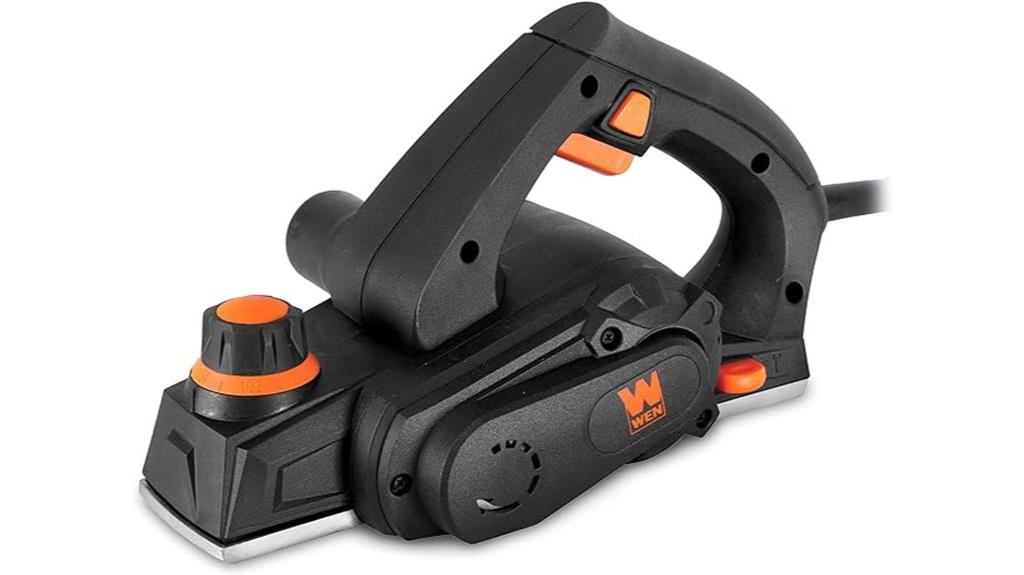
For DIY enthusiasts and light professional woodworkers seeking an affordable yet reliable hand planer, the WEN 6528 stands out with its powerful 3.8-amp motor capable of over 32,000 cuts per minute. It features a 2-3/8-inch cutting width with nine adjustable stops in 1/128-inch increments, allowing precise control up to 1/16 inch deep. Weighing only 4.3 pounds, it’s lightweight and easy to maneuver. The alloy steel base guarantees durability, and the included v-shaped grooves help shape corners. While it lacks a dust bag, it connects to a shop vac for dust extraction. Overall, it’s an efficient, budget-friendly tool perfect for smoothing, fitting, and minor wood adjustments.
Best For: DIY enthusiasts and light professional woodworkers seeking an affordable, reliable hand planer for smoothing and minor wood adjustments.
Pros:
- Powerful 3.8-amp motor capable of over 32,000 cuts per minute
- Lightweight (4.3 pounds) and easy to maneuver
- Durable alloy steel base with V-shaped grooves for shaping corners
Cons:
- Lacks a dust bag; requires connection to a shop vac for dust extraction
- Not compatible with 220V power supplies, limiting regional use
- Some users report challenges with left-handed operation
Jorgensen No.60-1/2 6-1/4 Mini Wood Planer
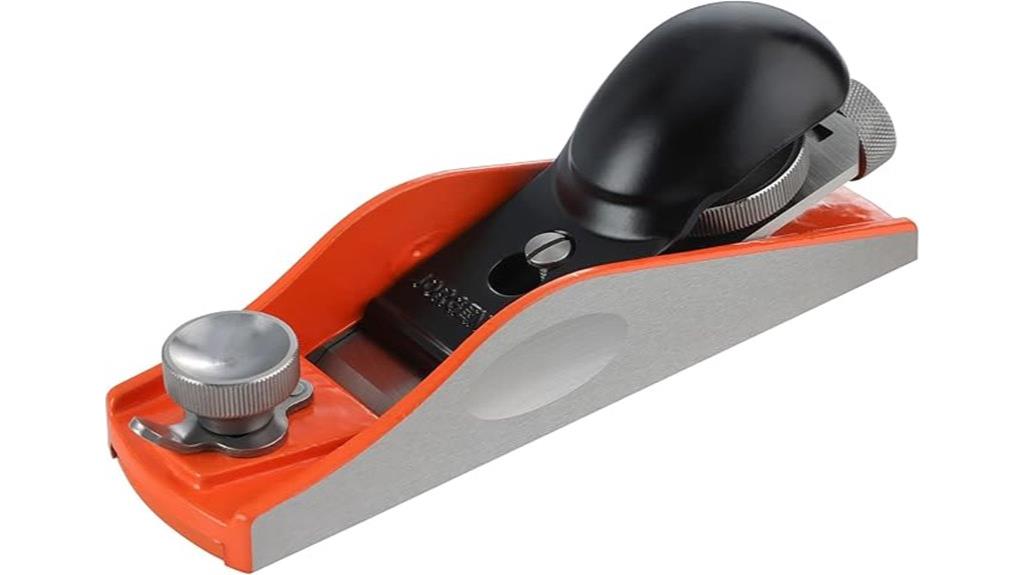
The Jorgensen No.60-1/2 6-1/4 Mini Wood Planer stands out as an excellent choice for DIY enthusiasts and light woodworking projects thanks to its compact size and manual operation. Made with a durable ductile iron body, it’s built to withstand heavy use. The sharp 9CrWMn O1 steel blade delivers efficient cuts, and its adjustable mouth and cutting depth let you customize your planing. Weighing just under 2 pounds, it’s easy to handle, with a polished flat sole for smooth results. While it may require some initial tuning and flattening, users appreciate its affordability, ease of use, and solid construction for small-scale or craft projects.
Best For: DIY enthusiasts and light woodworkers seeking an affordable, compact, and easy-to-use hand planer for small projects and craft work.
Pros:
- Durable ductile iron body and high-quality steel blade ensure long-lasting performance
- Adjustable mouth and cutting depth for customized planing results
- Lightweight design (under 2 pounds) for comfortable handling and precise control
Cons:
- May require initial flattening of the sole and honing of the blade before optimal use
- Less suitable for heavy-duty or fine woodworking compared to premium models from top brands
- Some users might find the tuning process necessary for achieving the best finish
Vevor 13-Inch Thickness Planer for Woodworking
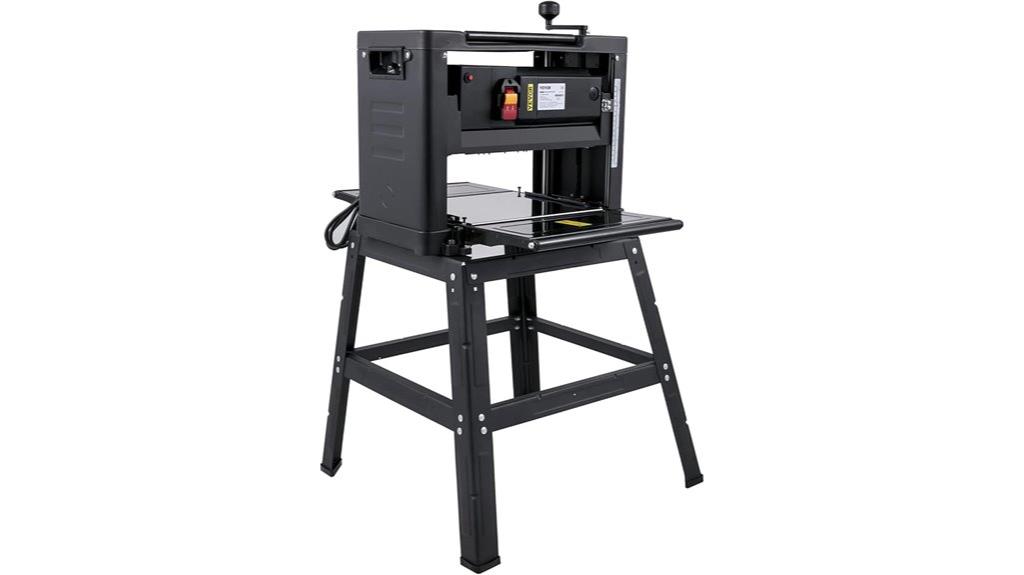
The VEVOR 13-Inch Thickness Planer is an excellent choice for both professional woodworkers and serious hobbyists seeking powerful, precise, and versatile operation. It boasts a 2000W motor, 8,000 RPM cutter head speed, and a maximum cutting width of 13 inches, making it suitable for large projects. Its adjustable planing depth and height ensure accurate results, while features like foldable tables, a detachable stand, and dust exhaust improve usability. Despite some assembly challenges, users praise its ability to handle rough or weathered wood and produce smooth finishes. Overall, it’s a reliable, high-performance tool that balances power and convenience for a variety of woodworking tasks.
Best For: professional woodworkers and serious hobbyists seeking a powerful, precise, and versatile benchtop thickness planer for large woodworking projects.
Pros:
- High power with a 2000W motor and 8,000 RPM cutter head for efficient planing of large and rough wood.
- Adjustable planing depth and height for precise control and smooth finishes.
- Foldable tables, detachable stand, and dust exhaust interface enhance usability and safety.
Cons:
- Assembly can be challenging, with unclear instructions for some components.
- The stand height may be too low for comfortable operation for taller users.
- Blades may wear quickly and require careful handling and replacement.
Amazon Basics No.4 Adjustable Universal Bench Hand Plane

If you’re looking for an affordable, reliable hand plane for light-duty woodworking projects, the Amazon Basics No.4 Adjustable Universal Bench Hand Plane stands out as a top choice. Made from durable cast iron, it offers stability and precise control with an adjustable gear for blade depth and angle. The steel alloy blade ensures quality cuts, and the impact-resistant plastic handle provides a comfortable grip. Weighing about 2.7 pounds, it’s easy to maneuver without fatigue. While some users suggest minor modifications, it’s perfect for household tasks like smoothing door edges or cabinets. Overall, it delivers excellent value for casual woodworkers and DIY enthusiasts.
Best For: casual woodworkers and DIY enthusiasts seeking an affordable, reliable hand plane for light-duty household projects.
Pros:
- Durable cast iron construction provides stability and longevity.
- Adjustable gear allows precise control over blade depth and angle.
- Lightweight (around 2.7 pounds) and easy to maneuver for extended use.
Cons:
- Some users find the build quality to be subpar and recommend parts replacement.
- Adjustment mechanisms can be challenging to calibrate initially.
- The handle and knobs are small or uncomfortable, especially for larger hands or detailed work.
Mini Wood Planer, 3 Inch Hand Woodworking Plane

For hobbyists and DIY enthusiasts working on small woodworking projects, the Mini Wood Planer, 3-inch hand woodworking plane, offers excellent precision and control. Its exquisite craftsmanship includes an adjustable blade, a sharp, durable stainless steel blade, and a smooth ebony body that prevents splinters. Weighing just 1.76 ounces, it’s lightweight and easy to handle for detailed tasks like surface smoothing, edge trimming, or chamfering small parts such as RC airplane components. Its modern design, black finish, and comfortable wooden handle make it ideal for soft woods like pine or basswood. Keep in mind, it’s best suited for small-scale projects and may not perform well on hardwoods or larger surfaces.
Best For: hobbyists, DIY enthusiasts, and small-scale woodworkers working on detailed projects such as RC airplane parts or miniature crafts.
Pros:
- Precise control and easy adjustment for small woodworking tasks
- Compact, lightweight design ideal for detailed surface smoothing and trimming
- Made of durable materials with a sharp stainless steel blade for clean cuts
Cons:
- Limited effectiveness on hardwoods or larger surfaces
- Some users report fragility and hardware weaknesses over time
- Not suitable for heavy-duty or prolonged woodworking projects
Woodworking Thickness Planer, 6-Inch Worktable Benchtop Planer 1800W
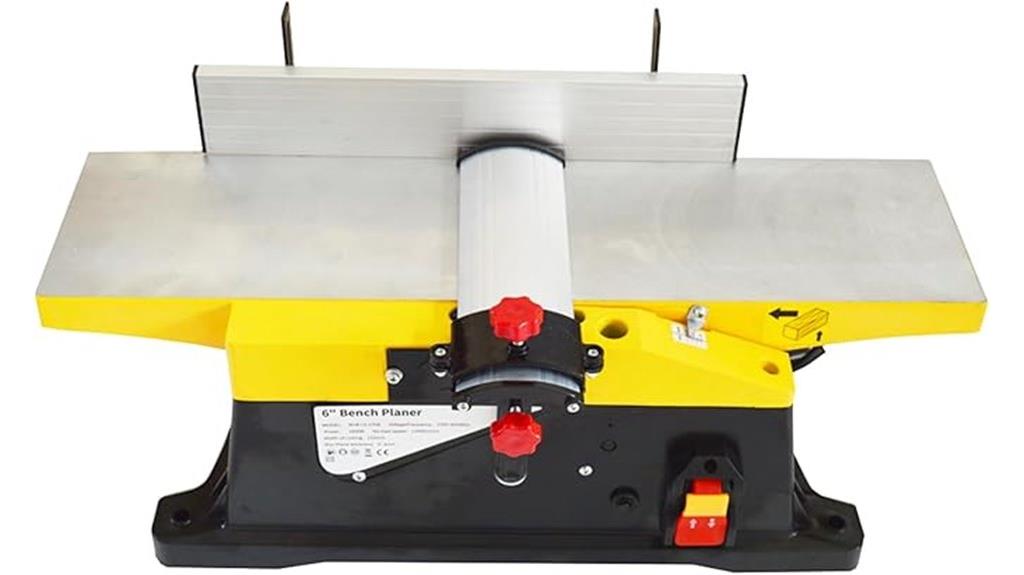
Designed for both professional carpenters and woodworking enthusiasts, the Woodworking Thickness Planer with a 6-inch worktable offers a powerful 1800W motor that handles tough milling tasks with ease. Its benchtop design makes it compact yet efficient, with a durable aluminum and metal construction ensuring stability and precision. The adjustable angle baffle (90°-135°) boosts processing efficiency, while the user-friendly red handle allows easy depth adjustments from 0 to 3mm. With a maximum cutting width of 6.1 inches and a no-load speed of 12,000 RPM, this planer delivers smooth, accurate results for various woodworking projects.
Best For: professional carpenters and woodworking enthusiasts seeking precise, powerful, and compact milling capabilities.
Pros:
- Robust 1800W motor handles tough milling tasks efficiently
- Adjustable angle baffle (90°-135°) enhances processing versatility
- Durable aluminum and metal construction for stability and accuracy
Cons:
- Limited maximum cutting depth of only 3mm may restrict certain projects
- Relatively lightweight (23.2 pounds), which could affect stability during heavy use
- Fixed cutting width of 6.1 inches may require multiple passes for larger pieces
Mini Wood Planer for Woodworking, 3 Inch Hand Planer for Smoothing and Trimming Wood
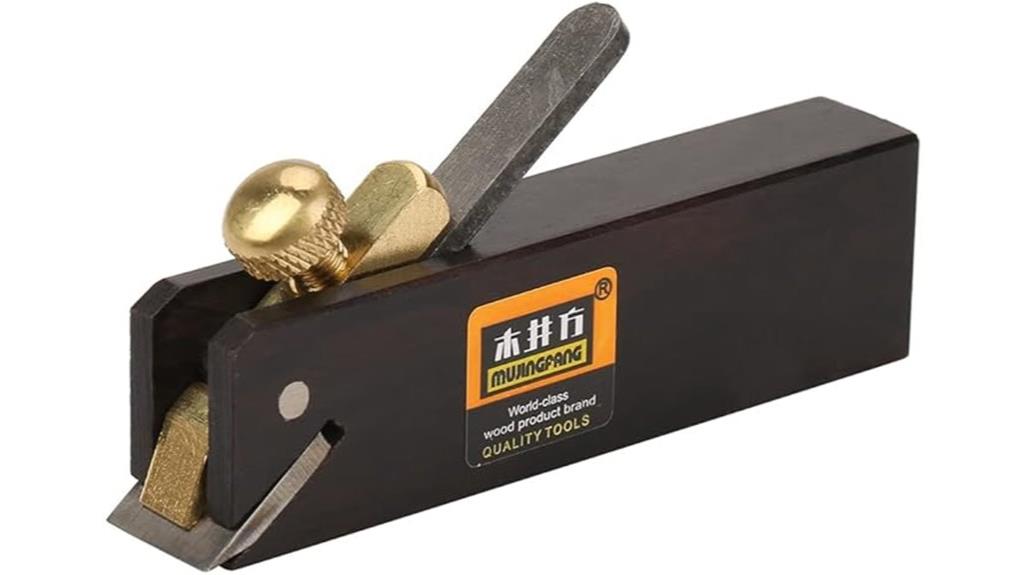
The Mini Wood Planer for woodworking stands out as an ideal tool for detailed projects requiring precision and control. Its compact 3-inch width makes it perfect for smoothing, trimming, and finishing small wood crafts, such as rounding edges or chamfering. Weighing only about 49 grams, it’s lightweight and easy to handle, especially for DIY enthusiasts and beginners. Crafted from durable ebony wood with a high-speed steel blade, it ensures sharpness and longevity. The adjustable blades and ergonomic design make it simple to customize and operate, providing a safe, efficient way to achieve finely finished surfaces on planks, plasterboard, and fiberboard.
Best For: DIY enthusiasts, woodworking beginners, and small craft project hobbyists seeking a precise, lightweight tool for smoothing and trimming small wood surfaces.
Pros:
- Compact and lightweight design (approximately 49g) for easy handling and control.
- Made of durable ebony wood with adjustable blades for versatile use.
- Manual operation requiring no batteries, suitable for detailed and precise woodworking tasks.
Cons:
- Blade movement during shaving can occur, affecting finish quality.
- Achieving a perfectly smooth surface may be challenging for some users.
- Limited cutting width (0.5 inches), making it less suitable for larger projects.
CNC Spoilboard Surfacing Router Bits (1/4 inch Shank, 1 inch Diameter)
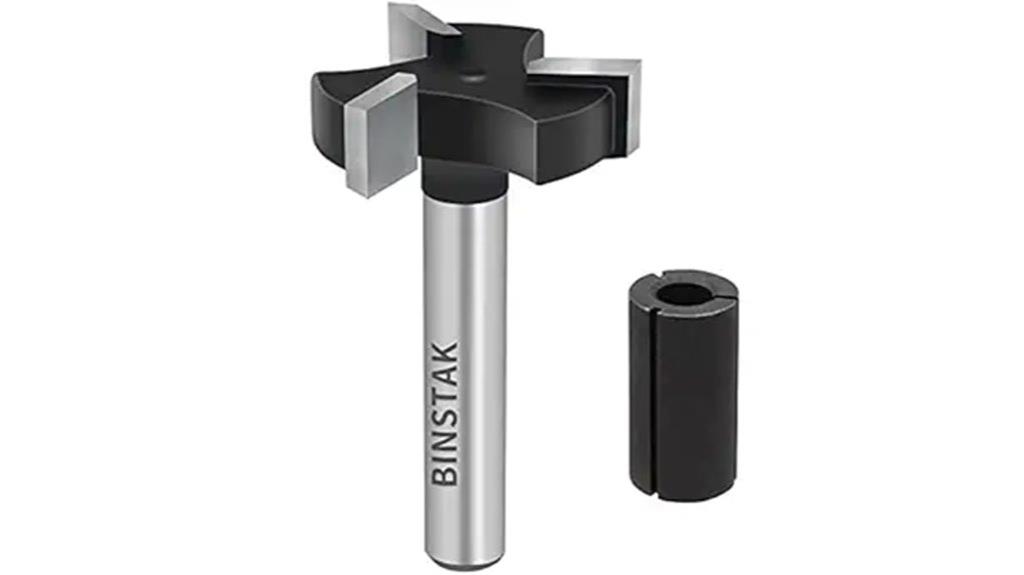
CNC spoilboard surfacing router bits with a 1/4-inch shank and 1-inch diameter are essential tools for anyone looking to achieve perfectly flat and smooth surfaces on large woodworking projects. These 3-wing carbide-tipped bits are made from high-quality hardened steel, featuring an anti-kickback design and heat-resistant Teflon coating to reduce resin buildup. They work well with CNC machines, routers, and handheld tools, ideal for flattening slabs, planing, trimming, and grooving across various materials like hardwoods, MDF, and plywood. While effective for heavy-duty tasks, some users note quick dulling and limited plunge depths, so occasional sharpening or replacement might be necessary.
Best For: DIY hobbyists and professionals seeking an affordable, efficient tool for flattening and surfacing large wood slabs and hardwoods with precision.
Pros:
- Effective at producing smooth, flat surfaces with minimal tram lines.
- Made from high-quality hardened steel with heat-resistant Teflon coating for easy cleaning.
- Versatile, suitable for use with CNC machines, routers, and handheld tools on various wood materials.
Cons:
- May dull quickly with frequent heavy-duty use, requiring sharpening or replacement.
- Limited plunge depth (1-2mm), which may restrict certain applications.
- Some users report burning or smoking during extended use, indicating potential for overheating.
CNC Spoilboard Surfacing Router Bit (1/4 Inch Shank, 1-1/2 Inch Diameter)
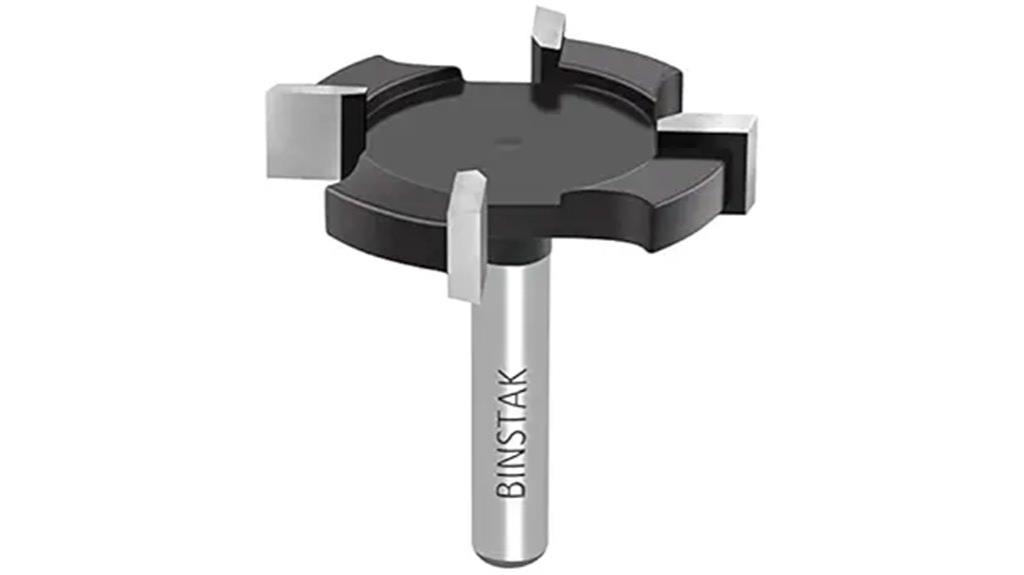
If you’re tackling large woodworking projects that require precise flattening and surfacing, the CNC Spoilboard Surfacing Router Bit with a 1/4-inch shank and 1-1/2-inch diameter is an excellent choice. Its oversized design makes it ideal for slab flattening, surfacing, and planing. The carbide-tipped blades and hardened steel body ensure durability, while the anti-kickback feature enhances safety. The heat-resistant Teflon coating reduces resin buildup, making cleanup easier. Suitable for CNC routers, handheld, and table-mounted machines, it works well on solid wood, MDF, plywood, and more. It’s perfect for achieving smooth, flat surfaces on large projects efficiently.
Best For: woodworkers and DIY enthusiasts who need to flatten and surface large slabs, desktops, or live edge wood with precision and ease.
Pros:
- Designed for heavy-duty use with durable carbide-tipped blades and hardened steel body.
- Effectively produces smooth, flat finishes on large surfaces with minimal witness lines.
- Heat-resistant Teflon coating simplifies cleaning and reduces resin build-up.
Cons:
- Some users may experience fitting issues with certain routers or shaft length limitations.
- Repeated use can dull the blades, requiring honing or replacement for optimal performance.
- Not suitable for cutting metal or non-wood materials.
CNC Spoilboard Surfacing Router Bits, 1/2 inch Shank, 2 inch Diameter
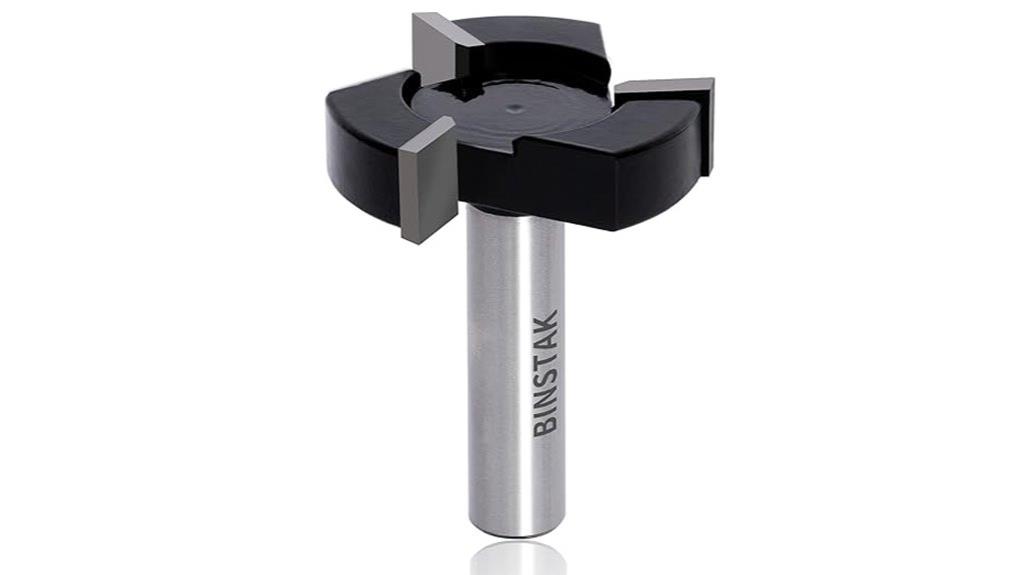
Ideal for hobbyists and small workshops, the CNC spoilboard surfacing router bits with a 1/2-inch shank and 2-inch diameter deliver fast, clean cuts on large wood surfaces. Crafted from durable carbide and carbon steel with a hardened steel body, they feature an anti-kickback design and a heat-resistant Teflon coating to reduce resin buildup. These bits are perfect for flattening slabs, resurfacing spoilboards, and trimming various wood materials. Their larger cutting surface minimizes burning and provides a smoother finish than smaller bits. Suitable for CNC and handheld routers, they offer efficient, burr-free edges, making them ideal for both detailed and large-scale woodworking projects.
Best For: hobbyists and small workshops seeking efficient, clean surfacing and flattening of large wood slabs and surfaces.
Pros:
- Durable construction with carbide and carbon steel for long-lasting performance
- Large 2-inch cutting diameter ensures smooth, burr-free edges and reduces burning
- Heat-resistant Teflon coating minimizes resin buildup, improving cutting efficiency
Cons:
- Not suitable for continuous heavy-duty industrial use or metal materials
- Requires compatible routers with at least 2HP and variable speed control for optimal performance
- May experience chip out or burn marks on resin-rich woods if feed rate and speed are not properly adjusted
Factors to Consider When Choosing Wood Planing
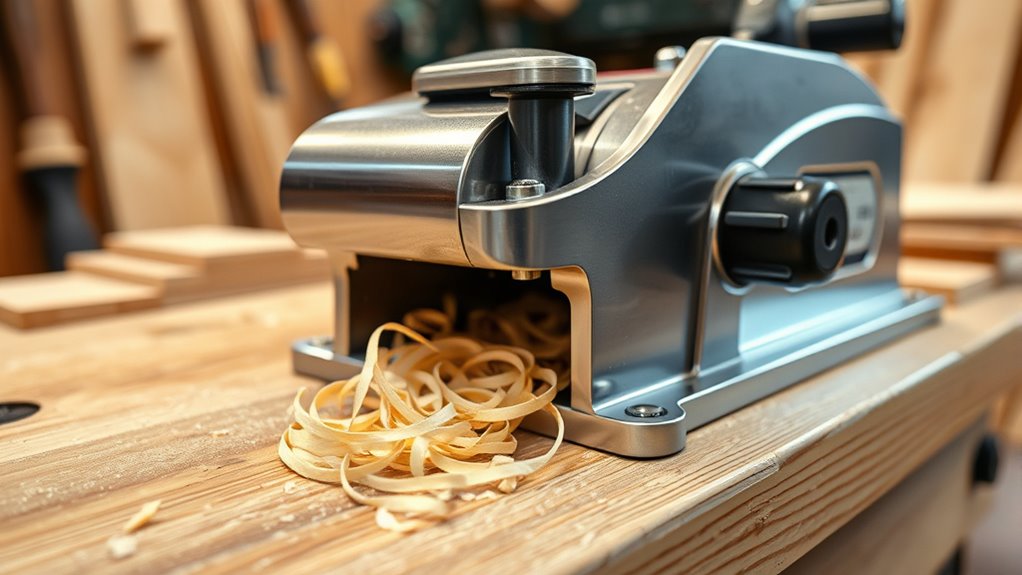
When selecting a wood planer, I focus on blade material and sharpness to guarantee clean cuts, along with adjustability for precise control. Size and portability matter depending on my workspace, and I also consider material compatibility to handle different types of wood. Ultimately, I look for models that are easy to maintain to keep my tool in top condition.
Blade Material and Sharpness
Choosing the right blade material and ensuring sharpness are crucial steps in achieving high-quality wood planing. High-quality blades made from O1 tool steel, carbide, or high-speed steel offer better edge retention and durability, meaning they stay sharp longer and cut cleaner. Sharp blades produce smoother finishes, reduce tear-out, and lessen the need for multiple passes, saving time and effort. Being able to sharpen or recondition blades repeatedly extends the lifespan of your tool and keeps performance consistent. Conversely, dull or low-quality blades can cause rough surfaces, damage the wood, and increase strain on you. Properly sharp, well-maintained blades are essential for precise, even results and to avoid unnecessary frustration during your woodworking projects.
Adjustability and Control
Adjustability and control are critical features that determine how effectively you can fine-tune a wood planer to match your project needs. A good planer lets you control the cutting depth and blade position precisely, ensuring consistent thicknesses and smooth surfaces. Features like vernier wheels, knobs, or screw mechanisms allow for small, accurate adjustments—sometimes as precise as 1/128 inch. An adjustable mouth opening helps customize the gap for different materials or finishes, improving the quality of the cut. The ability to easily modify angles and depths adds versatility, making the tool suitable for detailed work or chamfering. Reliable control mechanisms ensure smooth adjustments without backlash or slipping, which is essential for maintaining accuracy during repetitive or fine woodworking tasks.
Size and Portability
Size and portability are key considerations that can substantially impact how you use a wood planer. If you need a tool for quick tasks or on-the-go projects, a smaller, lightweight model is ideal. These planers are easy to handle and transport, often weighing under 2 pounds, making them highly portable. Compact planers with a cutting width of 1 to 3 inches are perfect for detailed work and tight spaces. On the other hand, larger benchtop models with wider capacities—6 inches or more—are better suited for extensive surface flattening but require more space to operate and are less portable. Consider how often you’ll move the tool and the storage space available. The right size guarantees efficiency without sacrificing convenience.
Material Compatibility
When selecting a wood planer, it’s essential to contemplate material compatibility to guarantee peak performance and surface quality. Make sure the planer’s blades and body materials suit the type of wood you’re working with—steel blades work well for hardwoods, while softer materials may require different blade types. Check that the cutting width and depth capacity align with your project’s size and thickness. It’s also important to verify if the planer can handle the wood’s moisture content and grain orientation, especially for dense or resin-rich species. Additionally, confirm that the tool’s construction and blade design suit the specific wood species, ensuring minimal tear-out, splintering, or damage. Proper compatibility helps achieve smooth, clean finishes efficiently and prolongs your tool’s lifespan.
Ease of Maintenance
Choosing a wood planer that’s easy to maintain can save you time and frustration in the long run. Look for models with corrosion-resistant materials like stainless steel or coated surfaces, which make cleaning simpler and reduce rust worries. Opt for tools with straightforward adjustment mechanisms and accessible parts—this makes tuning and repairs quicker and less tedious. Regularly sharpening and replacing blades is essential; sharp blades ensure smooth operation and prevent buildup of pitch and resin that complicate maintenance. Lightweight, ergonomic designs reduce fatigue, making routine cleaning and handling easier. Additionally, models with flat, machined soles and minimal moving parts simplify inspection, cleaning, and adjustments, extending the lifespan of your tool. Prioritizing ease of maintenance helps keep your planer performing at its best with less hassle.
Budget and Value
Balancing cost with features and durability is key to getting the best value from your wood planer. I always consider the overall cost relative to its performance, durability, and extra features. Cheaper models might save money upfront but often require frequent blade sharpening or replacements, which can add up over time. Investing in a higher-quality tool with sturdy construction and precise adjustments often pays off, delivering better results and lasting longer. Look for features like adjustable cutting depth and quality blades that improve efficiency and reduce the need for additional tools or repairs. Also, don’t overlook the warranty and after-sales support, as these protect your investment and ensure your planer remains reliable for years to come. Ultimately, choosing a tool that balances upfront cost with long-term value makes all the difference.
Frequently Asked Questions
How Do I Choose the Right Wood Planer for My Project?
Choosing the right wood planer depends on your project needs and budget. I consider the thickness capacity, motor power, and blade quality, ensuring it can handle the wood types I work with. I also look for user-friendly features like adjustable depth and portability. Reading reviews helps me gauge reliability. Ultimately, I pick a model that balances performance with affordability, so I can achieve smooth surfaces efficiently.
What Safety Precautions Should I Follow When Using a Wood Planer?
When using a wood planer, I always keep safety in mind. I wear eye protection and a dust mask because debris can fly around unexpectedly. I make sure my hands stay clear of the blades and never force the wood through—let the machine do the work. Connecting the planner to a dust collector helps keep my workspace clean and safe. Staying alert and following these precautions keeps me safe and my project on track.
Can Mini Planers Handle Large or Thick Wood Pieces Effectively?
Mini planers are great for small projects and detail work, but I wouldn’t rely on them for large or thick wood pieces. They lack the power and cutting capacity needed for big jobs, which can lead to uneven surfaces or strain on the tool. For larger or thicker wood, I recommend using a full-sized planer designed to handle the heft and guarantee smooth, consistent results.
How Often Should I Maintain or Sharpen My Wood Planer Blades?
Did you know that dull blades can reduce planing efficiency by up to 70%? I recommend sharpening your wood planer blades every 8 to 10 hours of use or when you notice rough surfaces and tear-out. Regular maintenance keeps your planer performing smoothly and extends blade life. I always check my blades before big projects to guarantee they’re sharp, making the work easier and results better.
Are There Specific Features to Look for in a Top-Rated Wood Planer?
When choosing a top-rated wood planer, I look for features like adjustable cutting depth for precise control, powerful motors to handle tough wood, and smooth feed rollers for even results. A sturdy build and easy blade change mechanism also matter. These features help guarantee I get smooth, professional finishes every time. Prioritizing these aspects makes my woodworking projects more enjoyable and the results consistently first-rate.
Conclusion
Choosing the right wood planer is like finding the perfect tool in a busy workshop—it makes all the difference. Whether you need a compact mini planer or a powerful electric model, I’ve highlighted options that deliver smooth surfaces every time. Remember, the best tool for you depends on your specific needs and projects. With the right planer, you’ll turn rough wood into a polished surface as effortlessly as a skilled artist paints a masterpiece.

